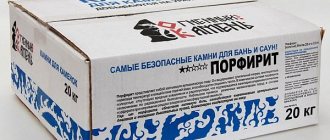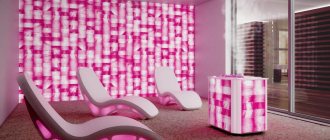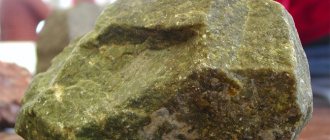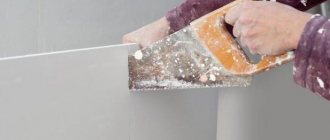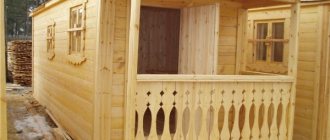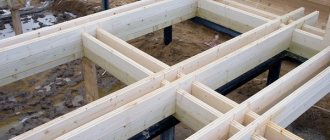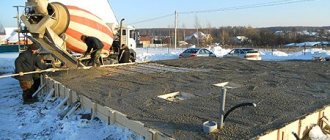Even in ancient times, Himalayan pink bath salt was used as a remedy for all diseases. And the whole point turned out to be that this salt contains a large number of different chemical components. There are more than 85 of them. And most importantly, the extraction and subsequent processing of salt does not reduce its chemical composition. If we talk about the quantitative content of elements, then it mainly contains large amounts of iron, copper, potassium, calcium and magnesium.
It is iron that makes Himalayan salt pink. Of course, depending on the proportional iron content, the shade of salt will change from pale pink to rich. But it should be noted that in nature there are both pure black and red-orange specimens. By the way, finishing the bath with Himalayan salt is not only the healing properties of the bath, but also a beautiful design.
It would seem that salt is a fragile material and quickly cracks. A little effort should separate it into several parts. But thanks to modern extraction and processing technologies, Himalayan salt can withstand serious loads, and this is not only temperature and humidity, it can withstand mechanical loads well. Let us add that salt stones for baths have a very high density, hence, in principle, their strength.
At high temperatures—Himalayan bath salt can withstand +550C—the salt releases negatively charged ions, so the microclimate in salt baths is similar to the sea climate. Salt air, saturated with vapor, disinfects the steam bath room, helps cleanse the respiratory tract in the human body, improves immunity, and calms the nervous system.
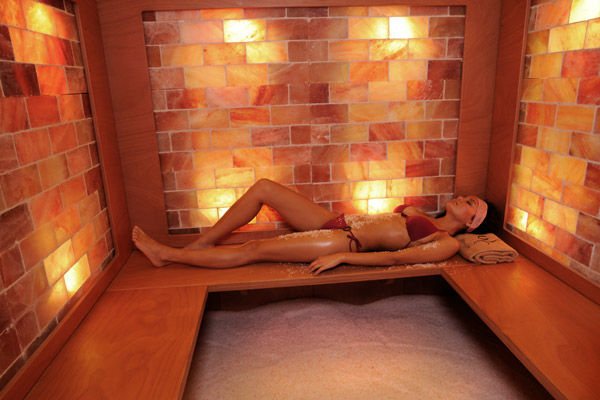
Attention! Not everyone is recommended to use salt baths.
Those who suffer from serious diseases of the skin, blood, or cancer patients do not belong here. The very decoration of the bathhouse with Himalayan salt tiles is very beautiful. It is not only a pink color, but also a unique pattern, a natural relief. And this, of course, greatly distinguishes it from artificial finishing materials. It should be noted that salt tiles and bricks are not cheap materials. Therefore, in order to somehow bring the bathhouse to the name “salt”, you can partially finish the surfaces of the room. For example, tile only one wall or a lounger with a floor. There are several variations. Although the best option with the highest effect is a steam room completely decorated with salt - floor, walls and ceiling.
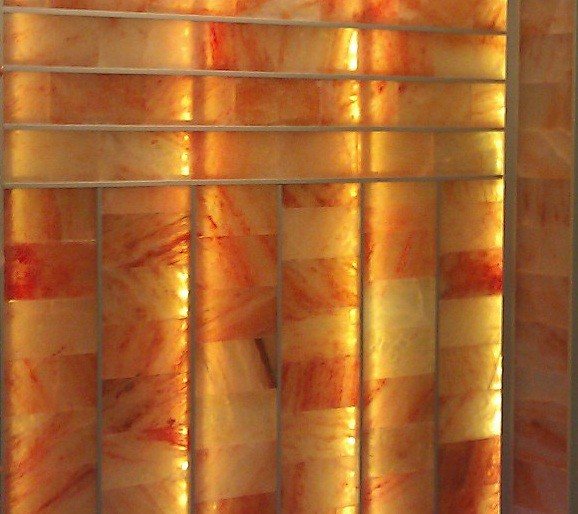
By the way, designers are increasingly resorting to such a technique as illuminating walls decorated with Himalayan salt. This is not only beautiful, but it also gives you the opportunity to avoid full lighting, which will save money. Although the one who finished the bathhouse with salt elements is unlikely to take such a trifle into account. And yet, the more spectacular the interior decoration of the salt bath, the more pleasant it is to be in it.
Pay attention again to the temperature that the salt can withstand. This makes it possible to finish the sauna stove with tiles. The only thing that Himalayan salt is afraid of is high humidity. Therefore, in steam rooms, the lining does not last long. The upper layers are gradually washed away by condensation, the tiles become thinner, so that the likelihood of cracking increases. But in saunas, where the humidity is low, finishing with salt tiles will last a very long time. The same goes for relaxation areas where you can relax under the influence of small amounts of salt humidity.
Attention! To increase the life of the salt finish, it is necessary to consider a well-functioning ventilation system. Rooms with such cladding must be ventilated.
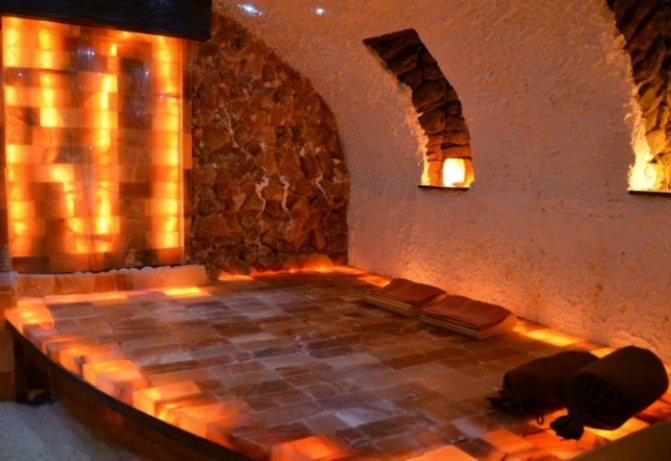
What is Himalayan salt
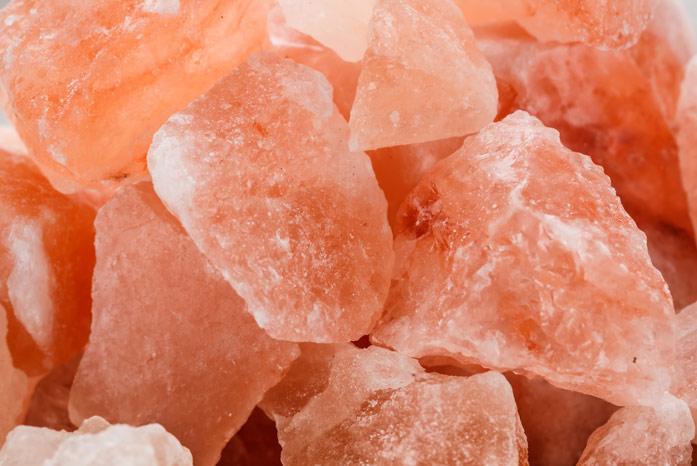
Himalayan salt is also suitable for cooking dishes, making them more piquant and delicious.
This is rock salt that is mined in Pakistan from the Khewra salt mine. It is located just 300 km from the Himalayan mountain range, which is why the mineral bears this name. According to the latest research, this salt was formed during the Jurassic period during volcanic processes between India and Eurasia. It appeared simultaneously with the Himalayas, after which it began to slowly settle down and accumulate - this is how the deposits that are now developed by people were formed.
Features of Himalayan salt are as follows:
- salty-sweet taste, unlike ordinary table salt;
- soft pleasant aroma;
- pink-orange color due to impurities of iron and other minerals;
- about 90 different microelements in the composition;
- 100% digestibility by the body;
- the lowest content of sodium chloride among all types of salt (for example, table salt consists of 98% of it, which is why it is harmful in large quantities);
- manual mining without the use of machines or explosives;
- no refining;
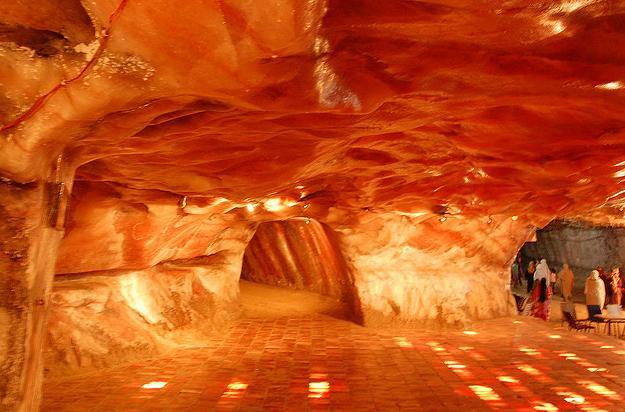
There are other deposits in different countries, but all of them are one way or another close to the Himalayas
Most often, the mineral has a pink or reddish color, but a black tint is also observed. This unusual color scheme makes the Khewra mine a popular tourist attraction. Among all the salt mines, including the extraction of ordinary table salt, Khewra ranks second in terms of production volumes, and third in terms of mineral reserves.
Black Himalayan salt is very similar to pink salt in structure and nature. It is distinguished by a pungent odor of hydrogen sulfide, but when heated it completely disappears. Black salt is also suitable for consumption. Hindus add it to traditional spices and to the national dish raita.
Useful properties of the mineral
Himalayan salt is a complex healing mineral. It is recommended not only by practitioners of alternative medicine, but also by doctors with good education and extensive experience. Salt has the following beneficial properties:
- supplies the body with important microelements (for example, iron, the lack of which is felt by many city residents);
- Helps cleanse the body and remove toxins;
- accelerates the restoration of damaged cells;
- calms the nerves;
- tones all the muscles of the body;
- kills harmful bacteria;
- externally rejuvenates the body;
- increases blood flow to the extremities (useful for people whose hands and feet are always cold).
Medical recommendations for the use of salt from the Himalayas boil down to the enormous benefits of its evaporation. The mineral evaporates when heated - both during cooking and during bath procedures. Salt vapors can treat a number of diseases:
- diseases of the digestive system;
- ailments of the genitourinary system;
- asthma;
- problems with the musculoskeletal system;
- vascular and heart diseases;
- hypertension;
- psoriasis, dermatitis and other skin problems;
- allergic reactions;
- irritation and inflammation of the gums;
- chronic fatigue.
You can also rinse your mouth with a salt solution to achieve fresh breath. And compresses or baths with saline solution relieve swelling on the legs and remove blue bags under the eyes.
Himalayan salt for baths and saunas: how to use correctly, medicinal properties and benefits
This mineral has high therapeutic activity, since it is the most natural and environmentally friendly on the planet.
In terms of the power of its therapeutic effect, it is superior to many medicinal drugs. The healing properties of Himalayan salt are due to the absence of harmful components. The uniqueness of this mineral is confirmed by the results of scientific research. Many of them clearly demonstrate that all the beneficial properties of salt are revealed during the heating process. The higher the heating temperature, the higher the therapeutic result can be obtained. When Himalayan pink salt is heated, steam is released, under the influence of which a microclimate is created in the room, which is similar in composition to natural mountain air.
There are some contraindications to using salt:
- pregnancy;
- diabetes;
- low or high blood pressure;
- vascular and heart disease;
- liver or kidney disease;
- blood circulation problem;
- existing acute diseases.
Increasingly, Himalayan salt is used in modern baths, which provides a powerful healing effect on the human body.
Salt has a natural crystalline base consisting of 85 useful microelements.
Himalayan bath salt is used to treat diseases of the respiratory system, cardiovascular and central nervous systems, and to prevent colds.
In the baths, equipped with various salt elements, the air is purified and ionized.
Himalayan salt is the purest material created by nature itself. The trace elements that make up the mineral bring maximum benefit when heated for a long time.
Salt is successfully used in modern beauty salons for rejuvenation procedures, as well as in saunas and baths for the prevention of many diseases of the human body.
Salt has the following medicinal properties:
- Promotes maximum cleansing and detoxification of the body;
- Maintains optimal water-salt balance;
- Provides the necessary supply of useful microelements;
- Restores and heals damaged skin;
- Rejuvenates and heals the body;
- Stabilizes blood pressure;
- Reduces nervous excitability and overstrain;
- Relieves muscle fatigue;
- Destroys pathogenic bacteria;
- Improves a person's overall well-being.
The benefits of using the mineral have been proven in the treatment of:
- Diseases of the gastrointestinal tract;
- Spinal diseases;
- Diseases of the urinary system;
- Diseases of the heart, lungs and blood vessels;
- Allergic and asthmatic reactions;
- Skin diseases.
Despite the obvious benefits of using Himalayan salt in a bath, such a product has some contraindications:
- Kidney failure;
- Oncology;
- Tuberculosis;
- Blood diseases;
- Individual intolerance.
A similar mineral is mined in special caves and comes in 3 types:
- Black;
- Pink;
- Orange with a reddish tint.
The most popular is pink salt. The main countries for mineral extraction are Kyrgyzstan, Poland, Ukraine, Pakistan.
The largest deposit was discovered in Pakistan, which was named after the great commander Alexander the Great. Extraction is carried out exclusively by hand without the use of special equipment that can damage the fragile structure of the mineral.
Himalayan salt for baths and saunas is the most effective way to rejuvenate and heal the body at any time of the year.
Therapeutic procedures using this mineral are becoming increasingly popular. In modern steam rooms it is used as a safe finishing material:
- Tile. Produced using a press, resistant to high temperatures and humidity;
- Brick. Wear-resistant and practical material. It can be polished or untreated;
- Blocks. Used for the construction of partitions, as well as for interior decoration of premises;
- Cubes. They are used as decorative panels in steam rooms and special relaxation rooms;
- Panels. They are produced by applying a thin layer of salt to a plastic or wooden base.
Each individual element is used in accordance with the concept of the room. Thus, slabs and salt bricks are used for interior decoration of the bathhouse. They have high light transmittance and give the room a soft amber color. Similar materials are used to decorate wall, ceiling and floor surfaces.
Cubes and blocks can be easily integrated into any base to create vibrant geometric shapes and compositions. Tiles are used for cladding stairs and partitions, and brick is used for walls, fireplaces and columns.
Decorative materials based on Himalayan salt are also suitable as floor coverings.
The maximum effect and benefits of health procedures in a salt sauna depend on the special conditions of staying in the steam room:
- The humidity of the room in which salt is used should be 53%. A temporary increase in humidity may lead to a decrease in the therapeutic effect;
- The presence of a permanent internal ventilation system in the steam room is mandatory;
- For installation of facing materials, a special mixture based on magnesite and magnesium chloride in proportions of 3:5 is used. Salt is diluted in purified water, then magnesite is added. The resulting mixture takes on a rich chocolate hue. Consumption of the adhesive mixture is 1:1 (1 kg of glue per 1 sq.m. of mineral elements). The glue completely hardens after 5 hours.
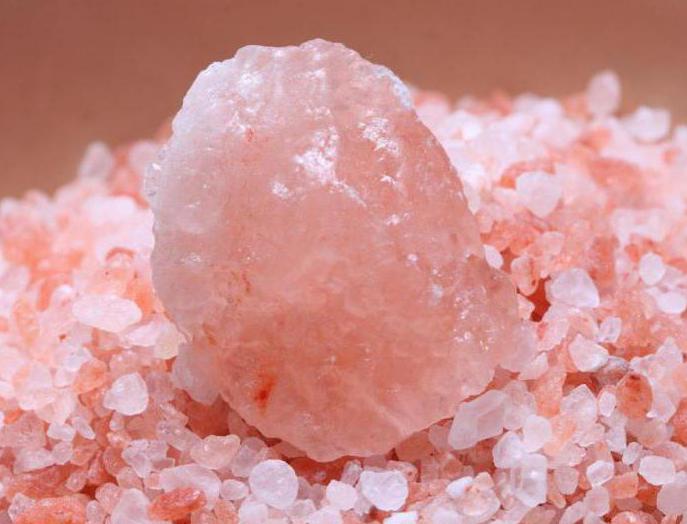
The simplest and most accessible way to use a mineral in a bath is to rub a handful of the mineral slightly moistened in water with soft circular movements into the body. Before starting the procedure, it is recommended to steam your body a little by visiting the steam room for 5 minutes.
Salt can be applied to the entire body, except for the face and neck. Next, you need to spend 8 minutes in the steam room, actively breathing the fumes. To get the maximum effect, it is recommended to use a bath broom. In this case, you can achieve a double effect - intense massage with a broom and safe cleansing of the skin.
After completing the procedures, it is recommended to replenish your water supply by drinking warm tea, herbal decoction or fruit drink.
The benefits of using such a unique mineral are absolutely independent of the forms in which it is presented.
The most common options for Himalayan salt for a steam room: pebbles, soap, lamps and scattering.
- Pebbles promote rapid ionization of the air in the steam room. When exposed to high temperatures, the mineral releases sodium chloride ions, which helps achieve maximum therapeutic effect. Pebbles are small pebbles based on pink salt. It is laid out on the heater to heat up and maintain an optimal level of air ionization;
- Soap is used as a cosmetic and medicinal product. This solution effectively affects the skin, promotes gentle cleansing, healing and nutrition. A soap solution made from the mineral normalizes the pH of the skin and slows down its aging.
- Particularly popular are lamps designed to create a special atmosphere of comfort and tranquility. They help purify and ionize the air in the steam room.
Carrying out regular bath procedures using Himalayan salt provides good support for the body in the fight against various diseases, helps relieve physical and emotional fatigue, and also improves immunity.
(15.00 out of 5)Loading…
Can it harm
Like any type of this mineral, Himalayan salt is harmful only in excess quantities. Its evaporation does not have a negative impact - you can at least build a bathhouse entirely from salt bricks. But you should consume salt internally in moderation: it still contains sodium chloride, albeit in relatively small quantities (from 15% to 20%).
Contraindications for interaction with Himalayan salt:
- malignant tumors (however, for benign ones, you must ask your doctor’s permission before using the mineral);
- blood diseases;
- thrombophlembitis;
- pregnancy;
- renal failure.
If you have any of the above problems, you must refrain not only from using Himalayan salt, but also from bath procedures in general. Its use should also be avoided if you have an intolerance or hypersensitivity to sodium chloride.
You should be wary of low-quality fakes. Often, under the guise of real salt from the Himalayas, they sell rock or sea salt, tinted pink. Such a counterfeit can harm the body due to dye fumes.
Brick for a bath - area of application
Brick baths are rightfully considered the most reliable and durable. Having correctly built a good brick bathhouse, you will forget about any problems for many years, it will not fail, the brick will not begin to rot, and pests are not afraid of it.
And one of the most important things is that this bathhouse will serve your grandchildren and great-grandchildren. But brick can be different; in this article we will look at its varieties and scope of application.
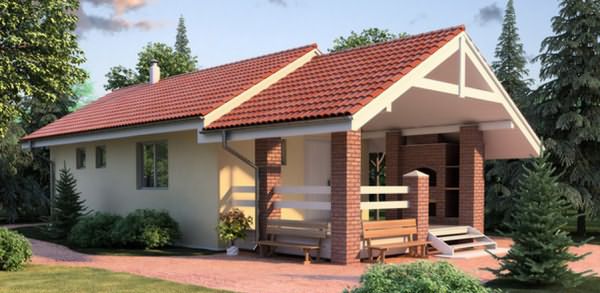
Photo of a brick bathhouse.
Types of products
- Red brick is the most commonly used material; walls, partitions and even stoves can be made from this material. For the walls, an ordinary hollow one can be used, since the walls in the bathhouse are made of two layers with a mandatory gap between the walls, which is filled with thermal insulation. Red cladding can be used for façade cladding. For laying brick ovens, heat-resistant grades M75 or M150 are used.
Solid block.
- Fireclay brick - refers to fireproof materials, made on the basis of fireclay clay. In the bathhouse it is used for laying furnace fireboxes, for arranging screens in wooden bathhouses and bathhouses with metal stoves. Also used for fireplaces, stationary barbecues or grills. The most suitable brands are ShA and ShB. Most often, ShB-5 is used for laying stoves.
Products made from refractory fireclay clay.
- Salt bricks for baths are a material that appeared relatively recently, they are salt blocks, the best are those made in Pakistan from salt mined in the Himalayan mountains. Salt blocks in the bathhouse are used exclusively for healing and improving the indoor microclimate. Their price is quite high, but the health benefits of their use more than cover all costs.
Salt blocks.
- Aerated concrete and foam concrete are the product of new technologies. They are blocks of a fairly large size; the material is porous, so it is light in weight. Even an amateur can build a bathhouse from aerated concrete with his own hands if he really wants to, you just need good instructions plus material. The blocks themselves are good heat insulators, so such bath structures do not require additional insulation. The only weak point of aerated concrete is that it absorbs moisture, but with proper external and internal finishing this disadvantage is reduced to zero.
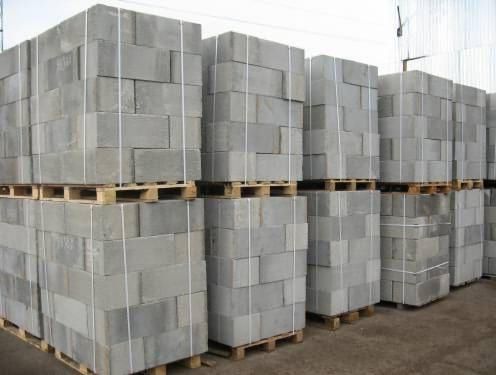
Aerated concrete.
- Sand-lime brick is not suitable for arranging a bathhouse, as it absorbs moisture and can only be used externally for cladding.
Silicate facing blocks.
Areas of use
Furnace laying
Currently, a lot of different stoves for baths are being produced, but we will consider a classic heater stove made of brick.
It is rightfully considered the most durable and beneficial in terms of healing effects.
Scheme of the heater.
- The foundation for a bathhouse stove is laid similar to the strip foundation of a house. Somewhat below the freezing point of the soil. A blind area is made of sand and gravel, formwork is mounted on it, a reinforcing frame is laid and concrete is poured. Such a foundation will harden for at least 1 month.
Important: the foundation for the furnace must be laid separately from the main foundation, the distance to the nearest wall is made at least 50 mm and covered with sand. Plus, the size of the foundation itself should be 50 mm larger than the furnace around the perimeter.
- Only solid, monolithic bricks are used for laying the stove. The best option is to lay out the entire stove from fireclay bricks, but the price is higher, so it is allowed to use M75 red brick for laying the base and chimney, and the firebox itself is made from fireproof fireclay ShB-5. Before laying, the brick is soaked in water.
- Waterproofing made of roofing felt in 2–3 layers is initially laid on the foundation. Since the foundation is initially laid slightly below the floor level, a base of 2 layers of brick is laid on it using cement mortar. A metal sheet and another continuous row rest on the base.
- Starting from rows 2 to 4 inclusive, there is a blower zone. In the 2nd row we begin to mount the door; before installation, a metal wire is attached to it, which is subsequently sunk into the solution in rows. The door is also wrapped around the perimeter with asbestos rope, which provides a damping gap.
Layout diagram.
Important: from the metal sheet and above, the stove is laid on fatty clay or modern special fire-resistant solutions. The thickness of the seam is made about 3 mm, it is convenient to control it; initially, 2 wires with a cross-section of 3 mm are placed on the brick; after laying, the wire is pulled out.
- Next, the firebox itself is laid out; exclusively fireproof fireclay material is used here. Before installing the 5th row, cast iron grates are installed. The height of the firebox is 5 rows, the width is 1.5 bricks, and the length is 3 bricks.
- After the firebox, a chimney is installed up to the ceiling with a gradual narrowing; at the top point its cross-section will be 1 brick. In the interfloor ceiling around the chimney, a metal box of 40x40 cm is made and filled with expanded clay, otherwise the materials bordering the pipe can quickly deteriorate due to temperature or even catch fire.
Screen in the bath
Quite often, metal stoves are used in the bathhouse. Modern metal stoves heat up the steam room quite quickly, but technologically many models require a brick screen.
The brick screen in the bathhouse acts as a case for the stove; it has channels for hot air convection and promotes smooth heating.
But when arranging the screen, you should take into account some of the design requirements.
Screen for a metal stove.
- The laying should be done vertically at a distance of 40 - 60 mm from the main metal casing of the furnace; this gap ensures the free movement of hot air.
- Cast iron doors are installed in the lower rows of the screen; with their help, the air supply during convection is regulated.
- The thickness of the screen is, as a rule, half a brick; it is not recommended to make it thinner, since the screen can overheat, but thicker is possible.
- Since a brick chimney is not used for metal stoves due to its large mass, the screen can act as a support for the chimney. In this case, its heat transfer increases many times over.
- It is recommended to use refractory fireclay bricks, but this recommendation is not mandatory, the fact is that the heating temperature of the screen is not so high and, in our opinion, any solid material can be used, and the screen can be laid on ordinary cement-sand mortar.
- When firing a furnace from an adjacent room, tunnels are built in the screen panel for access to the firebox and ash pit.
- The screen, which serves as a brick partition in a wooden bathhouse, is laid out completely up to the ceiling. In this case, the distance from the screen to the wooden walls should be at least 40 cm.
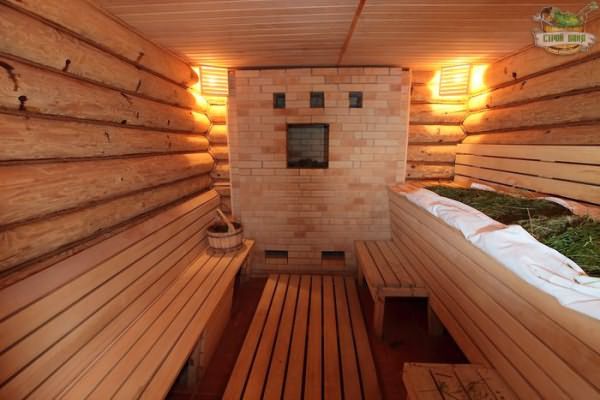
Steam room with screen.
Salt screens
Nowadays, everyone knows the therapeutic effect of salt chambers, lamps, and therapy in salt mines. By installing a small salt screen in your bathhouse, you will greatly increase the healing effect of visiting such a bathhouse.
To arrange the screen, special salt bricks for the bath are used. This is a natural material that is cut from a single monolith of salt and has a strictly defined shape. Salt blocks can withstand temperatures up to 500˚C, so they can be used to create protective screens around a metal heater.
It is possible to completely or partially lay out the partition between the steam room and the relaxation room from salt blocks. The blocks are laid using special fasteners or an adhesive solution based on caustic magnesite and magnesium chloride 3:5, initially salt is dissolved in the water, and then magnesite is added. It can be laid on liquid glass, but it is not durable.
Walls made of salt blocks in the steam room.
How to use it correctly in a bath
The use of the mineral in saunas, baths and steam rooms has a healing effect. Also, the evaporation of the mineral promotes weight loss and accelerates fat burning. Of course, you shouldn’t expect miracles: without proper nutrition and exercise, you’ll hardly be able to lose many kilograms. But the correct use of salt during bath procedures allows you to achieve impressive results.
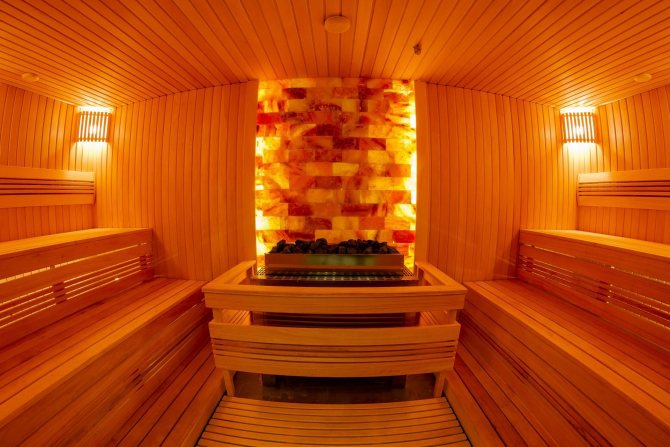
Not everyone can afford to build one or more walls from Himalayan salt.
There are several ways to use the mineral:
- Construction of walls. Salt bricks, slabs or other types of blocks are usually used for this. The brick is pure Himalayan salt, and the slab or block is a mineral that has been processed and added with building impurities. Therefore, bricks are considered the best option, although they are more expensive. All four walls will cost a pretty penny, so you can get by with just one - this will be quite enough to achieve a noticeable effect from the Himalayan salt.
- Laying the floor. If the floor of the bathhouse is made of salt bricks, then you can safely walk on it barefoot. If the bathhouse has been built a long time ago, you can remove the old floor and replace it with salt flooring. The effect of bath procedures will be the same as with a salt wall.
- Salt pebbles. Large smooth stones made entirely of salt should be placed on hot stones in the steam room before pouring water on them. This allows you to achieve maximum effect due to abundant evaporation.
- Installation of various decorative elements. Lampshades, bowls with Himalayan salt, panels, etc.
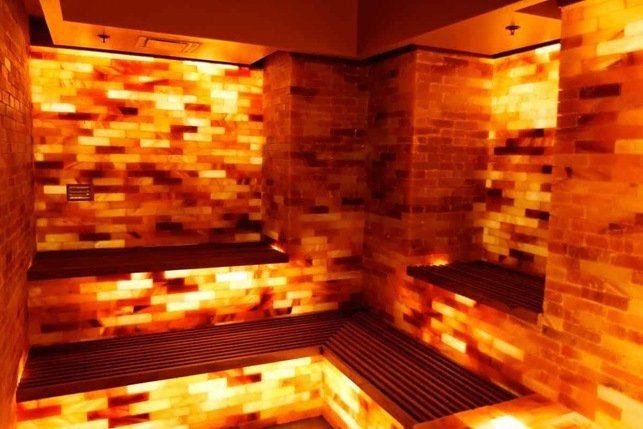
Himalayan salt can also be used to line the floor of a bathhouse.
When using Himalayan salt, you should follow the following basic rules:
- the humidity level in the room should not be higher than 53% when the sauna is not in use (a short-term increase in humidity during use does not harm the salt bricks);
- walls and floors made of salt must be wiped with a dry towel to remove excess moisture;
- do not forget about ventilation;
- Installation of a ventilation system is highly recommended.
There is no need to be afraid of high temperatures. Salt can withstand temperatures up to 500 degrees Celsius, so you can even build fireplaces from it. Moreover, the higher the temperature, the more intense the healing fumes.
How does a salt bath work?
As mentioned above, any bath can be made into a salt bath. To do this, you will have to use special tiles and bricks made from salt stones to finish the floor and walls of the steam room. All experts unanimously assure that the best option for finishing is Himalayan bath salt. It is actually brought from the Himalayas, where it is mined in large quantities. The tiles and bricks themselves are produced locally, although there are also purely Himalayan products. But compared to the first ones, they are more expensive.
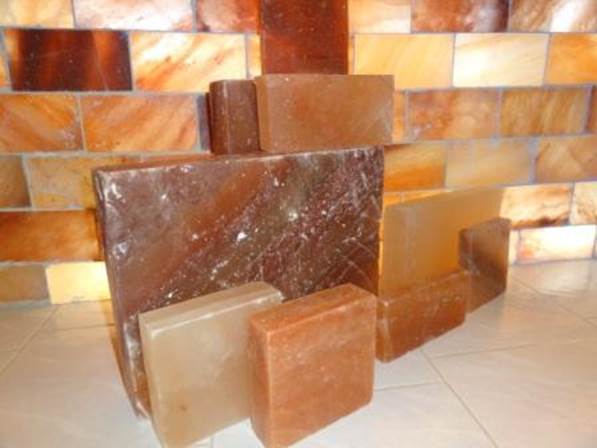
Types and installation of products made from Himalayan salt
Of course, not everyone wants to spend money on building an entire wall out of Himalayan salt or laying a floor with it. There are many more economical uses of this mineral in baths. The most popular installation methods:
- shade;
- bowl;
- panel;
- lamp.
Lampshade with salt
A lampshade is a good decorative element, but in a bathhouse it also serves a practical function. After all, the lighting device hidden behind the lampshade is used in conditions of high temperatures. So it should be:
- reliable in design;
- made from durable materials;
- moisture resistant;
- fireproof.
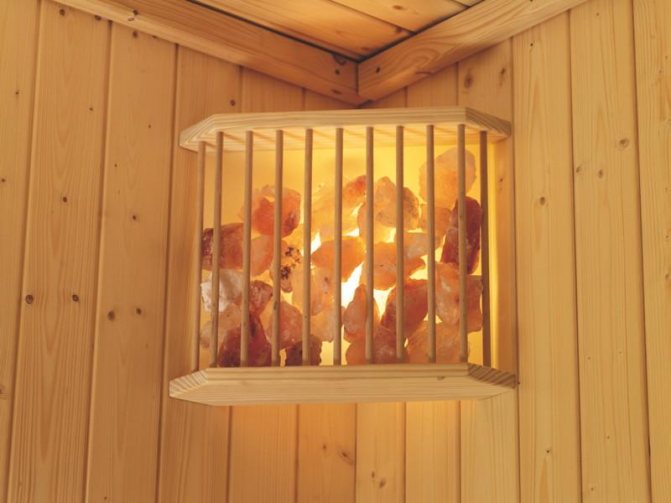
A lampshade made of wood with Himalayan salt will fit perfectly into the interior of the bathhouse.
Most often, lampshades are placed in the corners of the bathhouse directly under the ceiling or even close to it. There is a lighting fixture in the very corner, and between it and the wall of the lampshade, as can be seen in the photograph, there are Himalayan salt stones.
Materials from which you can make a lampshade for a bath:
- Tree. This option is good because the walls of the room are most often decorated with wood, and therefore the lampshade fits well into the interior. Also in favor of wood are its naturalness and environmental friendliness.
- Heat-resistant plastic, aluminum or stainless steel. These materials can be put on the same level, because they are slightly inferior to wood due to their chemical composition.
- Durable frosted glass. Used for decorative purposes, it provides endless design possibilities.
- Himalayan salt. Sometimes the lampshade is made from salt slabs. It's not cheap, but it's very effective.
Bowl of salt
The bowl is perhaps the most budget option. To bring it to life, you just need to buy a decorative bowl that would fit the interior of the bathhouse, place Himalayan salt inside in any form (pebbles are most often used) and hang it from the ceiling or wall mount. The materials are absolutely unlimited; the choice of appearance and shape of the bowl depends on the taste of the owner.
It is recommended to place the bowl close to the heat source so that the evaporation of the Himalayan salt is as intense as possible.
Decorative panel
This use of Himalayan salt is expensive, but very beautiful. It involves the creation of wall panels from salt stones and figured products. The panel is attached to the wall or, preferably, built directly into it.
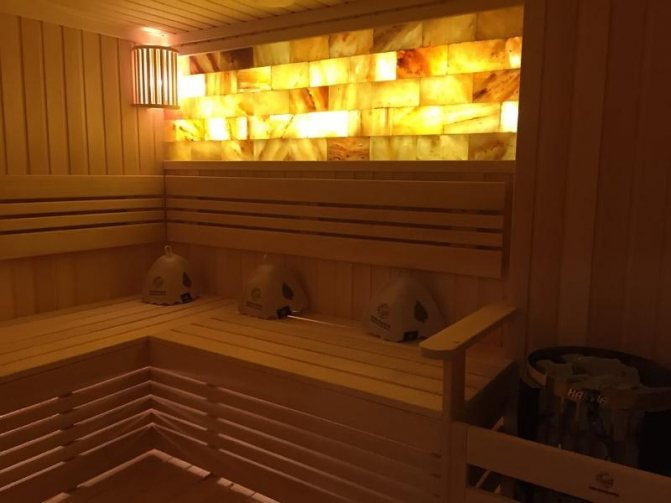
The panel will look especially impressive if you place beautiful lighting inside the wall. After all, translucent salt will not only transmit light, but also scatter it beautifully, creating a unique atmosphere in the bathhouse
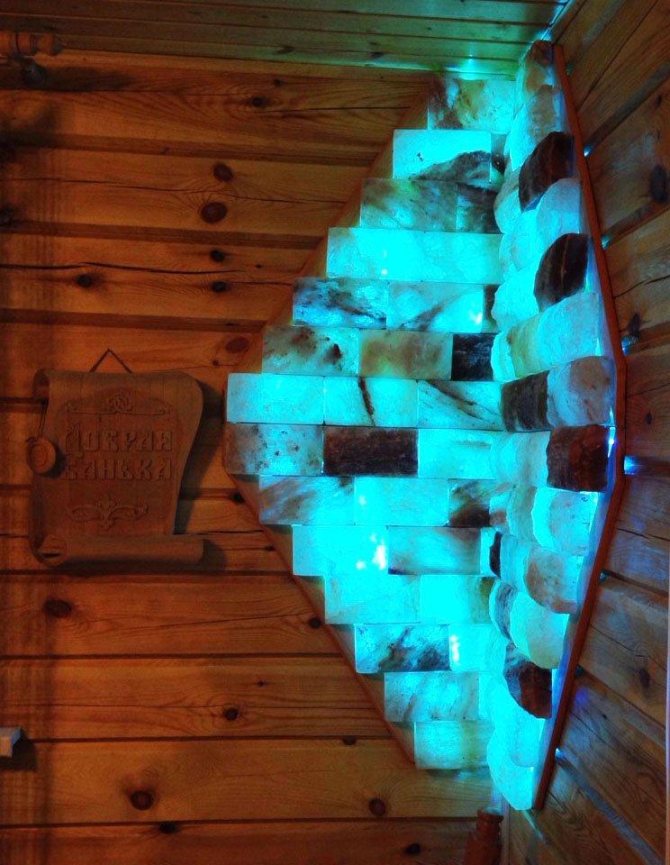
A Himalayan salt panel can have absolutely any shape and size.
The photographs show only two options for creating such decorative panels. Manufacturing methods are limited only by the author's imagination. You can also find ready-made panels made of Himalayan salt for sale.
Himalayan salt lamp
This method of using the mineral is quite unusual. The essence of such a lamp is a large salt stone, inside of which a light bulb is installed. Most often it is mounted on a stand, but there are also options that can be hung on the wall or hooked to the ceiling.
Lighting fixtures made from Himalayan salt are divided into 2 categories:
- natural (stone in its natural form);
- with decorative processing (some kind of pyramid or other figure is carved from stone).
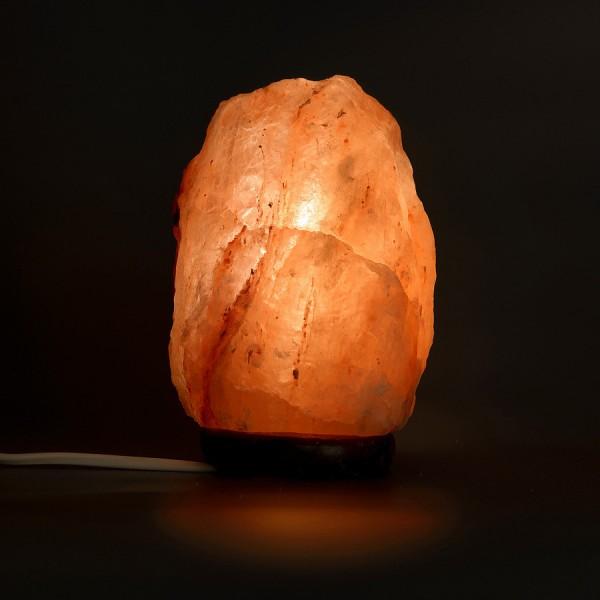
It is advisable to install at least 3-4 such lamps to achieve maximum effect
For medicinal purposes, it is better to use natural lamps, because the fumes from them are more active.
What is a salt sauna and what are its benefits?
It is known that each salt sauna, thanks to its properties, can significantly improve human health. Whatever the traditional baths, the salt bath still has a great advantage among all. The use of wood for building walls, although not a prerequisite, is still in Nowadays, so-called salt panels have gained great popularity. Such panels are used to build saunas or baths.
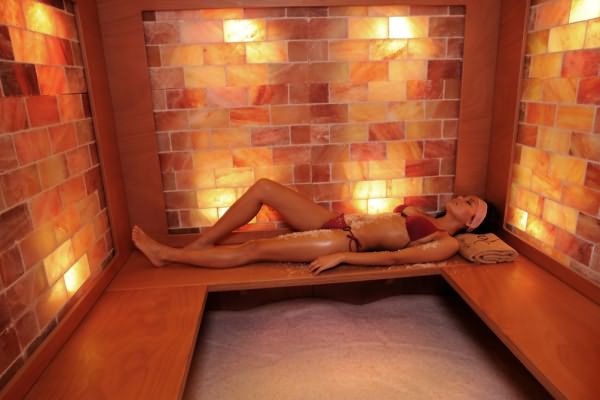
Since time immemorial, it was known about the healing properties of salt, and even treatment was carried out by spending some time in salt caves or mountains. Over time, people have learned to create conditions under which treatment is more productive, which is still practiced today. The salt bath is one of the best and most effective and, probably, the most healing of all existing ones. However, you will receive all the benefits provided that you follow all the rules of conduct. And then the salt bricks in the bathhouse will bring maximum benefit to your health and will have a positive effect on various diseases, in particular those of the respiratory system. So remember, a salt sauna will help you get rid of diseases and improve your condition in the future. Now let's look at the conditions for the best sauna, as well as effective and efficient salt for your health.
Conditions in a salt sauna and choice of salt
The temperature in the sauna should be maintained around 55 ºС. As for humidity, it should fluctuate around 30%. Salt tiles for a bath will help maintain humidity and temperature in the room. The duration of such treatment sessions should be about 25 minutes and no more than 30 minutes. There is no need to be zealous, since neglecting the rules can only harm your health. You can choose salt at your discretion, but experts consider Himalayan salt to be the best. Because it is this salt that contains the largest amount of useful microelements, which it releases when we heat the sauna blocks. This salt should only be stored in low humidity areas. The steam that hits the salt plates or salt bricks turns into water, and this, in turn, as you know, dissolves the salt, and it flows. Himalayan salts are highly dense and have a rock-like structure. This material is perfect for finishing salt rooms. Tiles, cubes, blocks, bricks - all these products made from natural salt are being sold today, and even more - salt tiles for baths are the leader among sales.
Advice from the master!
The walls of the sauna are usually lined with salt stones or blocks of natural salt, and the ceiling and floor are lined with salt crumbs.
Very often, for greater comfort, the floors are equipped with heating, and to emphasize the beauty, the ceiling is decorated with salt vaults, which stylizes the room as a cave. Often, such saunas are equipped with specially designed ionization and ventilation systems so that the air does not change, but is only cleaned of large drops of water, which do not have a very good effect on human health.
The benefits of a sauna
In the East, all diseases are treated with salt baths. For healing, sea salt is used or salt caves are visited, and salt stones are also in demand separately. Today, to experience all the benefits of healing salt, you don’t need to go to the sea, you can simply visit a salt sauna. To get maximum benefit from the procedure, you need to spend at least 20 minutes. You need to remember that a session that lasts more than 30 minutes will not bring you any benefit, but, on the contrary, can only aggravate the situation. Stones are materials that must be used in the construction of a bathhouse to maintain temperature, and they are also perfect as decoration; blocks are also one of the components of the building.
Such a building is most necessary for people who have problems with the respiratory organs. Using this procedure, bronchial asthma can be cured at the initial stage, obstructive and dust bronchitis, as well as allergic and chronic rhinitis during remission. A salt bath will be a good medicine for people who have problems with skin diseases such as dermatitis, eczema and neurodermatitis.
For healthy people, the sauna also has its benefits. A person who attends such a procedure will be shocked by the silkiness and smoothness of his skin. Only natural salts will help you experience all the healing properties of the sauna. Laying salt bricks along the entire wall is very expensive, so they can be replaced with cheaper decor. The benefits and harms of a salt bath can be closely intertwined; the main thing is to know what not to do during the procedure, namely:
- salt sauna is contraindicated for people with high fever and if the disease is not acute;
- It is imperative to follow the rules of behavior, not to stay for more than 30 minutes;
- Before the procedure, it is forbidden to eat foods that are difficult for the stomach.
An excellent option would be an outdoor sauna, where you can see the world around you. Curtains or curtains will save you from the hateful glances of your neighbor and people passing by. If the option of fresh air is not possible, then you should at least ventilate it using an open window.
Advice from the master!
It is simply necessary to ventilate the sauna after using it. However, the open space cannot be used for recreation, because it is not heated. If it is used as a place to relax, then the temperature must be kept the same as in the house.
poparimsya.com>



